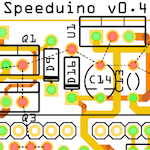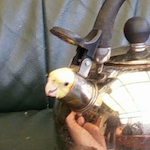|
No fuel in the cylinder when the spark plug goes off = not a drat thing happens. GM ran wasted spark setups on their V6s for ages, including on the 3800, even with the supercharger. If you run into ignition issues, how hard would it be to convert to Yaris/Corolla coils? They have a pretty short dwell time, and I would think they'd be easy to find locally. randomidiot fucked around with this message at 05:10 on Feb 5, 2017 |
|
|
|

|
| # ? May 8, 2024 21:53 |
|
Alternately, that motor shares some serious similarities to the mazda 3.0, whose coils are swappable with ford modular v8 coils (2 valve involves surgery on the connector, 4 valve requires making a hold down bracket). They need the spring and boot swapped from the old coils and one of two modifications. Not sure how compatible all this is with the jag version of the motor that had different heads.
|
|
|
|
I don't think he's going to find many Ford mod motors where he's at.  Finding the Mazda 3.0 would probably not be terribly difficult, but that's probably going to go right back to square one where he may be dealing with the coils not being able to keep up with the waste spark configuration. Finding the Mazda 3.0 would probably not be terribly difficult, but that's probably going to go right back to square one where he may be dealing with the coils not being able to keep up with the waste spark configuration.The Denso coils used on the Yaris and Corolla have a very low dwell time - around 2.5ms @ 14V. randomidiot fucked around with this message at 05:23 on Feb 5, 2017 |
|
|
|
The 3.0L was north america only iirc. If they have a version of the fusion/mondeo with the 3.0, maybe then. vOv
|
|
|
|
Yu-Gi-Ho! posted:No fuel in the cylinder when the spark plug goes off = not a drat thing happens. What I mean is, the ECU has only 3 ignition outputs, and although you can tell it that it's running a 6-cylinder engine, you can't specify that it's a V6. With no cam position sensor, how does it know which of the two cylinders in the pair is about to reach its power stroke? In an inline, this doesn't matter, as two cylinders reach their TDC at the same time. In a V6, no two cylinders reach TDC at the same moment, so the ECU surely needs to know exactly when to fire the pair of sparks.
|
|
|
|
Pomp and Circumcized posted:What I mean is, the ECU has only 3 ignition outputs, and although you can tell it that it's running a 6-cylinder engine, you can't specify that it's a V6. With no cam position sensor, how does it know which of the two cylinders in the pair is about to reach its power stroke? In an inline, this doesn't matter, as two cylinders reach their TDC at the same time. In a V6, no two cylinders reach TDC at the same moment, so the ECU surely needs to know exactly when to fire the pair of sparks.  Unless there's something particularly crazy about the Duratec you're using, it will have 120 degree spacing between firings. That means there will always be 3 pairs of cylinders where one cylinder will reach the top of its stroke at the same time as their partner, with each pair being spaced 120 degrees from the next pair and each cylinder in the pair being out of phase with the other (360 crank degrees apart). What the pairs are depends on the firing order. Once you've got the firing order, it's easy to wire them for wasted spark: 1st to fire with 4th to fire 2nd to fire with 5th to fire 3rd to fire with 6th to fire noisymime fucked around with this message at 14:19 on Feb 5, 2017 |
|
|
|
You're right. I was imagining that pairs of pistons mounted on the same crank journal would be firing 360 degrees apart, and such would be paired. However, for my purposes, their 'partner' pistons are actually always on the next journal over and on the opposite bank. (i.e. you pair front left with centre right, centre left with rear right, rear left with front right, which, when numbered from front to back, is how you wrote it  ) )Googling "v6 firing order" would have told me that I was being dumb!
|
|
|
|
Exciting progress today! I started by removing the dash, with the aim of having the interior-side of the firewall completely clear so that I could start cutting it. However, I was (and still am) currently stuck with an AC system full of R-134a and no hopes of evacuating it. Annoyingly, a second-hand recovery pump and tank sold locally on eBay yesterday for just £40, which would have been ideal. I'm toying with the idea of just paying a mobile AC tech to come empty the system.  I originally planned to remove the whole dash, with crash bar and heater box attached.This would have been great as it's only 12 bolts and one connector for the whole lot. However, I ended up just taking the dash pad off, which was a lot more time consuming, though I'm still not sure how I'd have found the strength to get the full dash out of the car on my own. I also removed the pedals, so that I could remove the brake and clutch master cylinders.  There is a known problem on these cars where the clutch pedal assembly can separate from the mounting plate. It's just held on with a few spot welds. Mine has begun the process already.  The big worry with this project is that the engine may not fit inside the car. Time to find out!  Getting it this far was slow. The engine needs to tuck under the firewall, but can't go in straight due to the steering rack in front. I have no way of tilting the engine (I have a leveler for the hoist but no way to attach it!) other than brute force with one hand and operating the hoist with the other.  The crank pulley hits on this small crossmember. In future, I will clearance this member to allow it to pass, but for now I'm stuck with having to remove the pulley.  I didn't have a 3-jaw puller, so I needed to improvise by tucking some bolt heads behind the pulley.   A few minutes later and it's in!!   Miraculously this thing fits, with just a few cm remaining on the length. The meticulous measurements taken beforehand were worth it!! There are a few spots on the firewall which I will need to cut out to allow the engine to move back a few more centimeters. My aim is to use a 10mm spacer - right now there is about 40mm between the engine and transmission.  The engine is very close up front. It's only just not-touching the steering rack, but that raised area on the timing cover is meant to accept the belt tensioner. I definitely need to move the engine back another 30mm.   Underneath looks great! The Mondeo ST220 oil pan was a shot in the dark, but it's a perfect fit - almost the same shape as the RX8 pan, and has perfect clearances all round   I had a feel inside the bellhousing and it feels like the transmission input shaft is aligned with the center of the crankshaft. At least, it's close enough for me to start basing my firewall-cutting measurements on.  Engine back out, and the areas to cut are marked. Also to be cut is the crossmember above the steering rack.I will cut about 3cm into the center part of it, to allow the engine to pass, and weld a plate on to seal it back up.  And with the last bit of light left in the day, I made the first cuts. These are pretty rough as I was mostly interested in what was behind the firewall, metal wise, and also paying attention to not setting the firewall padding on fire! The holes will be enlarged as required,likely the side towards the transmission tunnel will need a bit more clearance.  Finally, now it's dark, it's time to turn my attention to programming an Arduino to control the throttle pedal!  Inside, I discover that it is indeed hall-effect sensor based. Time to 
|
|
|
|
Good work on that fit, keep up the
|
|
|
|
cakesmith handyman posted:Good work on that fit, keep up the https://imgur.com/gbLkMqd No more posting for me tonight!
|
|
|
|
If it's hall-effect based and worth half a drat you should just get a convenient 0v-5v swing out of it (or similar) through its range, like a hall effect ebike throttle, which the analog input on ye olde 'duino should handle just fine
|
|
|
|
Hilariously, it has two sensors, neither have a linear output, and both have differing outputs (normally,the voltage rises on one, while falling on the other).This is intentional, to help verify that the system is functioning correctly. But that doesn't make it any less of a pain! Also, annoyingly, the Teensy doesn't handle more than 3.3V on its analog inputs.
|
|
|
|
Pomp and Circumcized posted:Welp, found this to be true first-hand today. Not going to go into details but it involved my Lexus hitting a near stationary car at 70mph and then still being perfectly drivable. Still totalled though SAY IT AIN'T SO 
literally a fish fucked around with this message at 10:40 on Feb 9, 2017 |
|
|
|
I'm not going to go into details, but it involved a highway-speed collision with two other vehicles. The Lexus held up surprisingly well. My calculations say it will be totalled, but only around £1100 in parts for me to repair it. I'm currently toying with either buying another one this weekend, or repairing this one and having ??? car in the meantime. Or buying another one, then repairing this one, then having two Lexus GSes.  
|
|
|
|
It was totalled for that? Or is there sub frame damage?
|
|
|
|
Alternatively, donate a 1uz to me... I kid, glad you're ok
|
|
|
|
You Am I posted:It was totalled for that? No subframe damage, just the bumper, fender, light, hood, arch liner, wheel, steering rack. The total came to 20% more than the value of the car (including labour and paint). I've already got two junkyards with all the bits lined up, and am currently pitting them against each other to give me the best price on the lot. Olympic Mathlete posted:Alternatively, donate a 1uz to me... Thanks
|
|
|
|
Pomp and Circumcized posted:If you want some UZZ32 control arms though, I have at least 24.  Holy poo poo. Holy poo poo.
|
|
|
|
Paging Phone.
|
|
|
|
Due to some hilarious rental/courtesy car mixup, my driveway currently consists of a Ford Fiesta and a Volvo V40. The lack of  is making me feel uneasy. is making me feel uneasy.
|
|
|
|
Let's backtrack to earlier in the week. On Monday evening, I spent a while finding the wiring pinouts for the accelerator pedal and throttle body. And also learning the basics of how I would integrate them into the Teensy. On Tuesday, I took the RX8 bits into work, and got them wired up and functioning, and able to give a voltage readout to an oscilloscope. The pedal takes 5V in and gives a 1-4.whatever volt range out. The throttle position sensors take a 12v (though they work at 7v) input, and give the same 0ish to 5sh volt output. Wiring up the components with some scrap wire and some random crimp connectors (think they are from a PC power supply?) that happen to fit well enough:  Wiring and probing the pedal sensor inputs:  Oscilloscope reading when I repeatedly mash the pedal:  The microcontroller chosen can only accept input signals up to 3.3V, so a pair of resistors were added to each input to create a potential divider. Diodes were later added as well to separate the inputs.The result is that my four sensors (there are two in the accelerator pedal, and two in the throttle body) are able to be connected to four unused inputs on the microcontroller. I took the whole lot home on Tuesday evening, and in 3 hours managed to create a basic program which reads the sensor inputs, compares the two pairs of input signals (2x pedal, 2x TPS) and checks them against each other to detect errors (also checks for 'out of range' values which may indicate an open or short circuit), averages them, and creates a PWM signal output, to drive the throttle motor.  I had the program output its status to the serial port, so that I could view changes in real time and not have to wonder why the program isn't working. This is a very, very useful debug tool, without it, I'd spend much longer thinking "why is nothing happening". I have the system set to run at 100 cycles per second - plenty for this application, but no stress for the Teensy's microcontroller.  I'm using the same Teensy that I use for CAN bus messages. I'm not sure if I'll end up asking too much of the tiny device, but if it struggles when fully loaded with work, I'll split its load over two Teensys. Squeezing the throttle pedal results in a higher voltage  Releasing it drops the voltage back down. It's like a rudimentary form of data logging.  This basic program turned out to be a success, and I'm now able to change the PWM duty cycle to the motor by pressing the throttle pedal. These 4 images show how moving the pedal (and changing the voltage (height) of the blue line) affects the duty cycle (width of the high part) of the yellow line. In this scenario, more yellow line at the top = more power output to the throttle motor.     What's left is to program a closed-loop system, which takes the TPS reading and moves the motor until it meets the pedal request reading. And also find a suitable power transistor to drive the motor. Then I need to add idle control, AC compressor idle-up, and maybe cruise control (if I can find some steering wheel controls for the RX8). I didn't have time to post all of this on Tuesday night. Unfortunately, on Wednesday morning, I was involved in an auto accident which has left me unable to continue work on the RX8 (for now, at least). Hopefully I'll be able to post some more interesting updates shortly! Pomp and Circumcized fucked around with this message at 00:35 on Feb 12, 2017 |
|
|
|
Neat. This sounds like a massive amount of work. How are you going to integrate the pedal/throttle control to the engine's ECU? Or are you doing something custom for that as well?
|
|
|
|
Larrymer posted:Neat. This sounds like a massive amount of work. How are you going to integrate the pedal/throttle control to the engine's ECU? Or are you doing something custom for that as well? I'm using both of the throttle position sensors to provide feedback for the throttle system. I realise that I need to send one of the signals to the ECU to allow it to control the fueling correctly. I'm hoping that I can simply Y-split off one of the sensors and send it to the ECU, and that this won't result in any unpredictable/erratic behaviour. If I'm not able to come up with any kind of system, I'll probably just end up using one TPS for the ECU and just one for the throttle system (and still keep two acceleration position sensors). The downside to this would be lack of error checking which could potentially lead to an unsafe situation. For example, the single throttle sensor gets stuck reading in the "I'm closed" position, and the system keeps trying to open it further and further, leading to it being stuck at WOT. I can implement checks for this (e.g. flag an error if the TPS goes out of range at either end, if its value doesn't change within a reasonable time/proportion to the PWM signal for the motor, if the value doesn't change for x cycles after changing a PWM value, etc. Another option is for me to output the average of the two TPS units from my throttle controller, but as this only cycles 100 times per second, there would be a delay between the throttles butterfly valve moving and this signal being received by the ECU. However, 100 cycles per second = 6000rpm, so perhaps that's acceptable? I'm in contact with the ECUs developer (who is also a goon), and will investigate how the TPS signal would be affected should I split it to two separate devices. Pomp and Circumcized fucked around with this message at 11:35 on Feb 12, 2017 |
|
|
|
Pomp and Circumcized posted:I'm in contact with the ECUs developer (who is also a goon), and will investigate how the TPS signal would be affected should I split it to two separate devices. If I understand your previous posts correctly, this is an analog 0V-5V signal generated by a Hall effect sensor module. Correct? Based on general principles these are the things which might make driving multiple loads a problem. 1. Sensor module's output is unbuffered 2. One or more loads demands high current The easy way to deal with problems like these is to build an op-amp buffer (follower) circuit to sit between the sensor and loads. That way the sensor module output drives only one load, and that load is almost infinite impedance so the sensor doesn't need to drive more than microamps. If one of the loads needs a lot of current, you can select a beefy opamp to drive it. You can even do 2 stages, where one follower buffers the original signal to the inputs of several more followers, one per load. If you haven't worked with opamps before, the first google hit I got seems to be decent university 101 course material. It eventually gets around to talking about followers, which are the simplest op amp circuit, but it's probably worthwhile to go through the other stuff first so you have the background. http://www.eecs.tufts.edu/~dsculley/tutorial/opamps/opamps0.html
|
|
|
|
Thanks for the link, awesome stuff. The Speeduino guys suggested the same thing, and I've incorporated an op-amp as a buffer for each input. For the sensor which will be split to go to the Speeduino, there are two op-amps in parallel. I'll post my circuit diagram once I've finished finalising it. But for now, here's where I'm up to so far: 
|
|
|
|
One thing I'd take a look at is that opamps frequently can't drive their outputs all the way to their supply rails. I looked up datasheets for the LM324D and all manufacturers of it mention that it can drive to its negative (ground in this case) supply rail, but are silent about how close it can get to its positive rail. (Or at least I couldn't find it within a few minutes of skimming / searching the PDFs.) Not specifying that parameter usually means it can't do it. One way to solve that issue is to run the opamp from a higher supply voltage, if one is available. At least +1V over your intended maximum output voltage should be fine. (Do not use automotive +12V directly for this, that is not clean power and needs a lot of conditioning to use for safety critical functions like this.) You could also select an opamp that advertises rail-to-rail drive capability. In practice it's almost never true rail-to-rail, but that might not matter. If the scale is 0V = idle and +5V = WOT, and the circuit can only drive +4.99V, you're not going to notice. Another thing: It's often a good idea to put clamping diodes on analog signals, especially ones sent over unshielded wiring looms in an engine bay. Each signal needs two diodes, connected like this to the supply and return rails for the IC you're trying to protect: Signal --->|--- +V Signal ---|<--- -V (usually GND) If the signal is within the range of [-V, +V] these 2 diodes won't conduct, but if it exceeds that range one diode will begin conducting, shunting current away from your IC into either the positive or negative supply rail. This should keep the IC from seeing input voltages outside its absolute maximum input range. It may be the case (probably is the case) that many of the ICs you're using have clamping diodes built in to their inputs. However, it doesn't hurt to add extra external ones, and these should be able to shunt quite a bit more current than whatever's built into the IC. Be sure to pay more attention to real analog people if you've got any giving you advice. Although I've done this kind of stuff before, I was never a real analog design engineer, and my career has gone down a different track over the past 10-ish years, so I'm rusty.
|
|
|
|
Using a 1HZ flywheel ls going to dull down your throttle response somewhat, those things are loving HEAVY. Bout 16KG without a clutch onto it. Be a torque monster with that much rotational mass tho 
|
|
|
|
BobHoward posted:One thing I'd take a look at is that opamps frequently can't drive their outputs all the way to their supply rails. I looked up datasheets for the LM324D and all manufacturers of it mention that it can drive to its negative (ground in this case) supply rail, but are silent about how close it can get to its positive rail. (Or at least I couldn't find it within a few minutes of skimming / searching the PDFs.) Not specifying that parameter usually means it can't do it. Thank you! I am running 5v as a supply voltage to the opamps, and need 3.3v at the inputs to the Teensy, so that should work out. Thank you for your advice on the diodes - I'll look at throwing those in - probably as packaged arrays for simplicity. I'll repost a schematic with those on. Either that or I'll choose opamps with built in clamping diodes (the LM324 was a bit of a placeholder since it's the only opamp array which I had memorised! I'll do some proper research at some point). Either way, I understand what you're saying  Edit: I have a stack of SP721s left over from my Speeduino board - I'll throw one of those over the 6 of my opamps which feed digital inputs. The schematic I've posted is still a work in progress - I'm sure there's still an abundance of capacitors which will need to be added to help filter out unwanted noise. This is a worry for me in this application, where I have hall-effect signal wires running near to PWM control for a fairly chunky motor. Couple that with injector pulses, etc, and it becomes an EMC nightmare! I have opted for Jaguar S-Type coils, as these have built in driver IGBTs, rather than mounting IGBTs on my board. Not because I'm adverse to building a driver circuit or purchasing the parts, but purely to keep EM interference as far as possible from my low voltage signals. I am also looking to replace the wiring for some sensors (Crank, Cam, TPS, O2) with shielded wiring to help combat unwanted interference. Toyota did this on the 1UZ so obviously it's the best thing to do ever. Pomp and Circumcized fucked around with this message at 23:11 on Feb 13, 2017 |
|
|
|
Ferremit posted:Using a 1HZ flywheel ls going to dull down your throttle response somewhat, those things are loving HEAVY. Bout 16KG without a clutch onto it. I saw that - what a beast!!! high torque is pretty much the exact opposite of what I need, when I have a 4.4:1 rear end. I can't seem to get any solid info on its bolt pattern, so can't guarantee that ti will fit on my crank. In fact, I've yet to find any flywheels except for a few rare Mondeos (ST200, ST24) which are a guaranteed fit. Another person who has swapped a V6 onto an RX8 gearbox went for the 'gently caress it' route, and had the RX8 flywheel drilled to an 8-bolt pattern, and then rebalanced. I'm leaning this way, as then I would only need a basic spacer to complete this part of the conversion. The whole flywheel/bellhousing adapter is the only real worry for me - I have no experience in designing or fabricating such parts, and we all know what happens when a flywheel misbehaves at high RPM. I'm still not sure which starter motor to use. The Jag has one mounted on the right hand side of the engine, which is where the exhaust pipe for the RX8 went. Using this would block my exhaust exit, and waste an alternative, perfectly useful space where the RX8 starter used to live. The RX8 starter lives on the left side of the gearbox, which is an excellent location and will allow me to run an exhaust with no issues. However, it is a well-known failure point on these cars, and is known to be so poo poo that it can often fail/barely manage to turn over a rotary engine - an engine which I can spin the flywheel of with one finger. I'm half tempted to keep the Jag flexplate, mount the RX8 flywheel on top of it with a spacer to match the bellhousing adapter, and have the option of which starter to run. Loser gets its ring gear stripped. Alternative option: dual starters 
|
|
|
|
Triple posting up in this bitch. Got everything up and running tonight. Looks like I need to study up on PID closed-loop motor control programming https://www.youtube.com/watch?v=jnZzm4L71dI
|
|
|
|
I'm impressed as hell but wouldn't a Megasquirt be way easier than Speeduino? I realize it's more money but this seems like you're resolving a lot of things that are already solved in the Megasquirt package.
|
|
|
|
It would be easier, but I want to do this on the cheap and I want to learn and experience all these things. Buying something off the shelf feels like a cop out. Integrating a homebrew (goon made!!) ECU into a car and making the car think it's stock is much more exciting! I'm aiming to complete this for £2k total. I'm currently still well under £1k and have yet to sell the RX8 engine or 80% of the Jag parts.
|
|
|
|
I imagine that and doing this let's you learn a whooooooooooole lot of poo poo. I'm actually amazed this works, full on wizard poo poo.
|
|
|
|
Pomp and Circumcized posted:This is a worry for me in this application, where I have hall-effect signal wires running near to PWM control for a fairly chunky motor. Couple that with injector pulses, etc, and it becomes an EMC nightmare! Sounds like you've got a good handle on what to be most worried about. Thanks for the thread, by the way. All the details about and restoration (or scrapping) of Soarers is really great stuff, and I'm looking forward to what you do with this project.
|
|
|
|
Thanks for all the words of encouragement. Tonight/tomorrows job is to sort out the wild oscillation in the throttle motor, as it is currently hunting for the correct value, then overshooting wildly with hilarious results. It's dark outside before I leave for work and dark again when I get home, so during the week, these electronic projects are all I can do to help the project progress. Hopefully it's not too dull, during each weekend I attempt to do some metal-related bits!
|
|
|
|
Pomp and Circumcized posted:Thanks for all the words of encouragement. Tonight/tomorrows job is to sort out the wild oscillation in the throttle motor, as it is currently hunting for the correct value, then overshooting wildly with hilarious results. You might want something like a PID algorithm on that?
|
|
|
|
Pomp and Circumcized posted:Triple posting up in this bitch. Big Chuck's Robot Warehouse and Auto Shop might have some help for you here. His entire design series on the RageBridge motor controllers has a lot of good information and useful code. You could also look at control loops used for multirotors, perhaps? You probably don't actually need the D part of PID, just proportional/integral.
|
|
|
|
Thanks guys, yes, my plan is to incorporate proportional control, and move to PI if needed (probably will be). The difference between my setup and most others is that my motor only runs in one direction, with a spring to act in the other direction, so 'lack of power' is the driving force to close the butterfly valve. I may still go with a two-directional PI controller, set to half of my max value (e.g. from -127 to 127), then add 128 to it. The link you posted doesn't work, is it this one? http://www.etotheipiplusone.net/?cat=85
|
|
|
|
Pomp and Circumcized posted:It would be easier, but I want to do this on the cheap and I want to learn and experience all these things. Buying something off the shelf feels like a cop out. Integrating a homebrew (goon made!!) ECU into a car and making the car think it's stock is much more exciting! That is awesome, you are awesome, this thread is awesome.
|
|
|
|

|
| # ? May 8, 2024 21:53 |
|
Pomp and Circumcized posted:Thanks guys, yes, my plan is to incorporate proportional control, and move to PI if needed (probably will be). The difference between my setup and most others is that my motor only runs in one direction, with a spring to act in the other direction, so 'lack of power' is the driving force to close the butterfly valve. I may still go with a two-directional PI controller, set to half of my max value (e.g. from -127 to 127), then add 128 to it. H-uh, looks like charles has broken SSL on his site. If you clip the S out of the https you should be good. OTOH that is the right category for the ragebridge stuff, yeah.
|
|
|





















